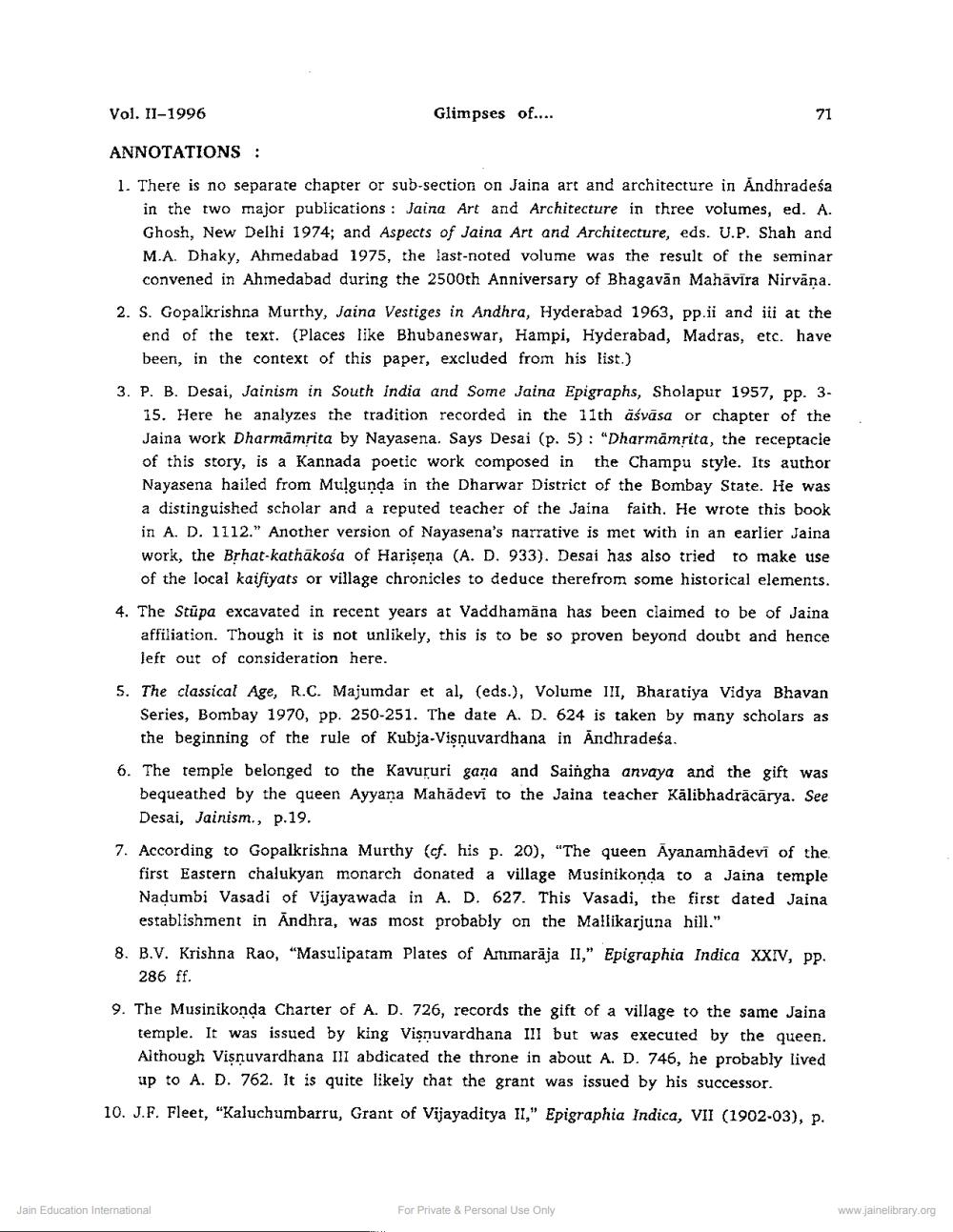Book Title: Glimpses of Jaina Vestiges in Andhradesa Author(s): H Sarkar Publisher: Z_Nirgrantha_1_022701.pdf and Nirgrantha_2_022702.pdf and Nirgrantha_3_022703.pdf View full book textPage 7
________________ Vol. 11-1996 Glimpses of.... ANNOTATIONS : 1. There is no separate chapter or sub-section on Jaina art and architecture in Andhradeśa in the two major publications : Jaina Art and Architecture in three volumes, ed. A. Ghosh, New Delhi 1974; and Aspects of Jaina Art and Architecture, eds. U.P. Shah and M.A. Dhaky, Ahmedabad 1975, the last-noted volume was the result of the seminar convened in Ahmedabad during the 2500th Anniversary of Bhagavān Mahavira Nirvana. 2. S. Gopalkrishna Murthy, Jaina Vestiges in Andhra, Hyderabad 1963, pp.ii and iii at the end of the text. (Places like Bhubaneswar, Hampi, Hyderabad, Madras, etc. have been, in the context of this paper, excluded from his list.) 3. P. B. Desai, Jainism in South india and Some Jaina Epigraphs, Sholapur 1957, pp. 3. 15. Here he analyzes the tradition recorded in the 11th āśvāsa or chapter of the Jaina work Dharmāmrita by Nayasena. Says Desai (p. 5): "Dharmāmrita, the receptacle of this story, is a Kannada poetic work composed in the Champu style. Its author Nayasena hailed from Mulgunda in the Dharwar District of the Bombay State. He was a distinguished scholar and a reputed teacher of the Jaina faith. He wrote this book in A. D. 1112." Another version of Nayasena's narrative is met with in an earlier Jaina work, the Brhat-kathakośa of Harisena (A. D. 933). Desai has also tried to make use of the local kaifiyats or village chronicles to deduce therefrom some historical elements. 4. The Stüpa excavated in recent years at Vaddhamana has been claimed to be of Jaina affiliation. Though it is not unlikely, this is to be so proven beyond doubt and hence left out of consideration here. 5. The classical Age, R.C. Majumdar et al, (eds.), Volume III, Bharatiya Vidya Bhavan Series, Bombay 1970, pp. 250-251. The date A. D. 624 is taken by many scholars as the beginning of the rule of Kubja-Vişnuvardhana in Andhradeśa. 6. The temple belonged to the Kavururi gana and Saingha anvaya and the gift was bequeathed by the queen Ayyana Mahadevi to the Jaina teacher Kalibhadrācārya. See Desai, Jainism., p.19. 7. According to Gopalkrishna Murthy (cf. his p. 20), "The queen Ayanamhādevi of the first Eastern chalukyan monarch donated a village Musinikonda to a Jaina temple Nadumbi Vasadi of Vijayawada in A. D. 627. This Vasadi, the first dated Jaina establishment in Andhra, was most probably on the Mallikarjuna hill." 8. B.V. Krishna Rao, “Masulipatam Plates of Ammarāja II," Epigraphia Indica XXIV, pp. 286 ff. 9. The Musinikonda Charter of A. D. 726, records the gift of a village to the same Jaina temple. It was issued by king Visnuvardhana III but was executed by the queen. Although Vişnuvardhana III abdicated the throne in about A. D. 746, he probably lived up to A. D. 762. It is quite likely that the grant was issued by his successor. 10. J.F. Fleet, "Kaluchumbarru, Grant of Vijayaditya II," Epigraphia Indica, VII (1902-03), p. Jain Education International For Private & Personal Use Only www.jainelibrary.orgPage Navigation
1 ... 5 6 7 8
